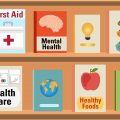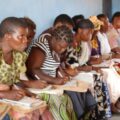Health education is an applied field of study that incorporates elements of biology, psychology, sociology and education in an effort to enhance individual’s abilities to maintain and/or enhance their health and their quality of life. The goal of health education is to provide experiences for people to be able to develop the skills and acquire the knowledge necessary to lead healthy lifestyles. This is accomplished by promoting the development of peoples’ attitudes, knowledge and skills regarding their health behavior.
Health education can be performed in a variety of school or community settings. School health educators might be employed at the elementary, middle, or high school levels. As teachers, their primary daily interaction is with school age children, however, they also work with adults (e.g., colleagues, parents, and various community members). Community health educators might work in medical care facilities, or community based agencies (e.g., a local hospital or chapter of the American Red Cross). They may develop a wide range of health programs for people of all ages or they may specialize in one area of health (e.g., injury prevention, nutrition, or substance use and abuse) with one specific population
In this article you will learn about teaching methods as well as some of the teaching materials you will be using in your work. Teaching methods refers to ways through which health messages are used to help solve problems related to health behaviors.
Teaching methods
There is a wide variety of teaching methods that you will be able to use in your health education work. You will be able to adapt these methods to your own situation, so that you can use the most effective way of communicating your health education messages.
Health talks
You may consider that the best way of communicating your health messages in certain situations is by using health talks. Talking is often the most natural way of communicating with people to share health knowledge and facts. In the part of your job that involves health education, there will always be many opportunities to talk with people.
Group size is also important. The number of people who you are able to engage in a health talk depends on the group size. However, you will find talks are most effective if conducted with small gatherings (5–10 people), because the larger the group the less chance that each person has to participate.
Question
Think of some situations when you think it might be best to use health talks to get across your health education messages.
Answer
Talking is a very flexible form of communication. Talks can be conducted with one person, or with a family or a group of people, and you can adjust your message to fit the needs of that group. One example of this would be communicating a health message to a group of young mothers about their use of contraception. Even informal talks can include information about the benefits and side-effects of using contraception.
Talking to a person who has come for help is much like giving advice. But as you will see, advice is not the same as health education. To make a talk educational rather than just a chat you will find it beneficial if it is combined with other methods, especially visual aids, such as posters or audiovisual material. Also a talk can be tied into the local setting by the use of proverbs and local stories that carry a positive health message.
Preparing a talk
When you are preparing a talk there are many things to consider:
- Begin by getting to know the group. Find out its needs and interests and discover which groups are active in your locality.
- Then select an appropriate topic. The topic should be about a single issue or a simple topic. For example, although local people need help about nutrition, this is too big as a single topic to address in one session. So it should be broken down into simple topics such as breastfeeding, weaning foods, balanced diets, or the food needs of older people. Always ensure that you have correct and up-to-date information and look for sources of recent information. There may be leaflets available that can support your health messages.
- List the points you will talk about: Prepare only a few main points and make sure that you are clear about them.
- Next, write down what you will say: If you do not like writing, you must think carefully what to include in your talk. Think of examples, proverbs and local stories to emphasise your points and which include positive health messages
- Visual aids are a good way to capture people’s attention and make messages easer to understand. Think of what you have available to illustrate your talk. Well-chosen posters and photos that carry important health messages will help people to learn.
- Practice your talk beforehand: This should include rehearsing the telling of stories and the showing of posters and pictures.
- Determine the amount of time you need: The complete talk including showing all your visual aids should take not more than about 20 minutes. Allow another 15 minutes or more for questions and discussions. If the talk is too long people may lose interest.
Question
Look again at the list of seven features of preparing a talk. Think about those areas in this list that you are confident about, and then those areas where you feel you will have to do some learning and practicing.
Answer
The list shows the benefits of being well prepared. As you will see, only point 6 is actually about rehearsals! Most of the list is about being sure you know your audience and that you are well informed and know what you want to say and show. So, if you are nervous, then remember that you can cut down on anxiety by taking this list seriously and being very well prepared.
There are, of course other variations on talking. But all of them rely on the same key features, which are knowing your audience, being well prepared and practicing.
Lecture
You may have the opportunity to give a lecture, perhaps in your local school or in another formal setting. A lecture is usually a spoken, simple, quick and traditional way of presenting your subject matter, but there are strengths and limitations to this approach. The strengths include the efficient introduction of factual material in a direct and logical manner. However, this method is generally ineffective where the audience is passive and learning is difficult to gauge. Experts are not always good teachers and communication in a lecture may be one-way with no feedback from the audience.
Lecture with discussion
You may have the opportunity to give a lecture and include a follow-up discussion, perhaps in a local formal setting or during a public meeting.
However there are also strengths and limitations to this approach. It is always useful to involve your audience after the lecture in asking questions, seeking clarification and challenging and reflecting on the subject matter. It’s important though to make sure discussion does happen and not just points of clarification.
Group discussion
Group discussion involves the free flow of communication between a facilitator and two or more participants (Figure 10.4). Often a discussion of this type is used after a slide show or following a more formal presentation. This type of teaching method is characterized by participants having an equal chance to talk freely and exchange ideas with each other. In most group discussions the subject of the discussion can be taken up and shared equally by all the members of the group. In the best group discussions, collective thinking processes can be used to solve problems. These discussions often develop a common goal and are useful in collective planning and implementation of health plans. Group discussions do not always go smoothly and sometimes a few people dominate the discussion and do not allow others to join in. Your job as the facilitator is to establish ground rules and use strategies to prevent this from happening.
Question
Handling group members requires patience, politeness, the avoidance of arguments and an ability to deal with different people without excessive authority or belittling them publicly. Think for a moment about how you might prevent a few people from dominating a group discussion.
Answer
The key skill in group work that may prevent such domination is by encouraging full participation of everyone in the group. You may be able to ensure participation in several ways, for example by using questioning and by using other methods that facilitate active participation and interaction. Quiet or unresponsive participants need to be brought into the discussion, perhaps by asking them easy questions so that they gain in confidence. Conversely, any community member dominating the discussion excessively should be restrained, possibly by recognising his or her contribution, but requesting information from someone who has yet to be heard. Sometimes it may be necessary to be more assertive, by reminding a dominant member of the objectives of the meeting and the limited time available.
In recent years, the use of posters in communicating health messages has increased dramatically (Figure 10.7). Since a poster consists of pictures or symbols and words, it communicates health messages both to literate and illiterate people. It has high value to communicate messages to illiterate people because it can serve as a visual aid.
The main purposes of posters are to reinforce or remind people of a message received through other channels, and to give information and advice — for example to advise people to learn more about malaria. They also function to give directions and instructions for actions, such as a poster about practical malaria prevention methods. Posters can also serve to announce important events and programmes such as World Malaria Day.
Visual aids like posters explain, enhance, and emphasize key points of your health messages. They allow the audience to see your ideas in pictures and words.
- Written messages should be synchronized with pictures or symbols.
- All words in a poster should be in the local language or two languages.
- The words should be few and simple to understand. A slogan might contain a maximum of seven words.
- The symbols used should be understood by everyone, whatever their educational status.
- The colors and pictures should be ‘eye-catching’ and meaningful to local people.
- Put only one idea on a poster. If you have several ideas, use a flip chart (see below).
- The poster should encourage practice-action oriented messages.
- It is better to use real-life pictures if possible.
- It should attract attention from at least 10 metres away.
Flip chart
Flip charts are useful to present several steps or aspects that are relevant to a central topic, such as, demonstration of the proper use of mosquito nets or how HIV is transmitted. When you use the flip chart in health education you must discuss each page completely before you turn to the next and then make sure that everyone understands each message. At the end you can go back to the first charts to review the subject and help people remember the ideas.
Leaflets
Leaflets are the most common way of using print media in health education. They can be a useful reinforcement for individual and group sessions and serve as a reminder of the main points that you have made. They are also helpful for sensitive subjects such as sexual health education. When people are too shy to ask for advice they can pick up a leaflet and read it privately.
In terms of content, leaflets, booklets or pamphlets are best when they are brief, written in simple words and understandable language. A relevant address should be included at the back to indicate where people can get further information.
Think for a moment about how you have seen printed materials used for health education messages. Think about posters which have been successful and made an impact, about how other health educators have used flip charts. So you can always ‘copy’ the way that other people do things. If you have a talent yourself or know someone else who does, you can experiment with posters and flip charts
Home-made posters and visual aids can be cheap and very effective.
Visual materials
Visuals materials are one of the strongest methods of communicating messages, especially where literacy is low amongst the population. They are good when they are accompanied with interactive methods. It is said that a picture tells a thousand words. Real objects, audio and video do the same. They are immediate and powerful and people can play with them!
Question
Think about what real visual materials you might take with you to a health education meeting. We’ve already mentioned bed netting for demonstrating prevention of malaria, but there are other real objects too. Think about family planning, nutrition, hygiene and so on.
Answer
If your display is on ‘family planning methods’, display real contraceptives, such as pills, condoms, diaphragms, and foams. If your display is on weaning foods, display the real foods and the equipment used to prepare them.
Audio and audio-visual materials
Audio material includes anything heard such as the spoken word, a health talk or music. Radio and audio cassettes are good examples of audio aids. As the name implies, audio-visual materials combine both seeing and listening. These materials include TV, films or videos which provide a wide range of interest and can convey messages with high motivational appeal. They are good when they are accompanied with interactive methods. Audio-visual health learning materials can arouse interest if they are of high quality and provide a clear mental picture of the message. They may also speed up and enhance understanding or stimulate active thinking and learning and help develop memory.
Summary
In this article, you have learned that:
- To be most effective you will have to decide which type of teaching methods and materials will suit the specific messages that you want to convey. It is also important to understand who your target groups are and what resources you have at hand to meet your communication objectives.
- The most important teaching methods are talks, lectures, group discussions, buzz groups, demonstrations, role-plays, dramas and traditional means of communication such as poems, stories, songs, dances and puppet shows.
- Health learning materials include posters, flip charts and leaflets, visual materials such as real objects, and audio-visual material such as TV, films and videos.
- Often more than one approach is more effective than a single type of activity. Using the right teaching methods and learning materials for the right target group in your health education programme helps you to convey effective messages to individuals and communities. This stands the best chance of bringing about health-related behavioural change.
Self-Assessment Questions (SAQs)
Now that you have completed reading the article , you can assess how well you have achieved its Learning Outcomes by answering these questions. Write your answers in your Study Diary and discuss them with your Tutor at the next Study Support Meeting. You can check your answers with the Notes on the Self-Assessment Questions at the end of the article .
Explain the difference between teaching methods and health learning materials and give examples of each of them.
Answer
Teaching methods are ways through which health messages are conveyed. Learning materials are printed, visual or audio-visual aids that are used to help you and support the communication process, in order to bring about desired health changes in the audience. Examples of learning methods are: lecture, lecture with discussion, role play and drama. Examples of teaching materials are: posters, leaflets and flipcharts.
Which of the following statements is false? In each case explain why it is incorrect.
A The health education method which is superior to any other method is drama.
B The lecture method is good for helping an individual with their health problems.
C Role play is a method which is spontaneous and often unscripted.
D The teaching method that has the saying ‘Telling how is better than showing how?’ is the demonstration method.
E A poster should contain more than one idea and its importance is to give information only.
Answer
A is false. In health education there is no method which is superior to any other method. Choice of methods depends on some important points that need to be taken into consideration. The method must suit the situation and the problem, so before choosing a method the person delivering health education must understand the problem at hand and the background of the audience.
B is false. A lecture is usually a spoken, factual way of presentation of the subject matter to many people. It is passive teaching because there is no opportunity for individual health problems to be discussed in lecture methods.
C is true. Role play is a spontaneous or unrehearsed acting out of real-life situations where others watch and learn by seeing and discussing how people behave in a certain situations. There is usually no script.
D is false. In a demonstration ‘showing how’, is better than ‘telling how’.
E is false. Each poster should contain one idea. Its importance is more than just giving information. A poster can reinforce or remind people about a message that has been received through other channels; give information and advice; or give directions and instructions for actions. It may also announce important events and programmes.
Which of the following statements is false? In each case explain why it is incorrect.
A Audio-visual materials and real objects are particularly useful in situations where the literacy rate of a group is very high.
B Real objects are useful learning aids because people can actually see and touch them — and they are immediate.
C Audio-visual materials and real objects are used only as a last resort when there are not enough posters to show.
D Demonstrations are activities where the use of real objects enhances the learning that people achieve.
Answer
A is false. In fact just the opposite is true. It is generally thought that audio-visual materials and real objects work well with audiences where the level of literacy is low.
B is true. Real objects can help people literally have a ‘hands on’ learning experience which can be very powerful.
C is false. Real objects and audio-visual materials are suitable for some circumstances and posters for others. Sometimes you will want to use all of them. It is a matter of knowing what will be effective for your audience.
D is true. Demonstrations are the ideal place to use real objects. In fact if you do not use real objects (or models) in demonstrations then you will not be able to show how to do something in a convincing way. SEE: Qualities of A Good Public Health Educator






